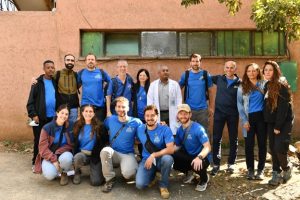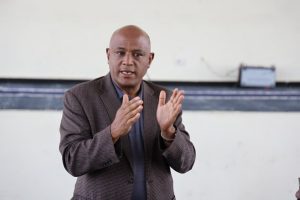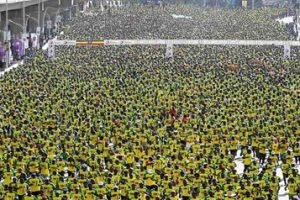
Although it has insignificant contribution to the emission of gases to the atmosphere, Ethiopia is one of the most vulnerable countries to the effect of climate change and global warming.
As a result, sectors such as agriculture, water, health and energy are critically affected.
Agriculture is the mainstay of Ethiopia’s economy and a means of living for 85 percent of the population. It also leans on traditional ways.
As the agriculture is a rain-fed one, when extreme weather condition occurs, the consequence will be disastrous. Therefore, to keep the sector sustainable reducing dependency on nature should be prioritized. Also, utilizing better technology and farming method should be taken as a way out.
Dawud Mume is Director of Policy Plan under Commission of Environment, Forest and Climate Change as and budget preparation Directorate.
As to him, the government of Ethiopia has nine major development directions cascaded from the United Nations sustainable development programs to be attained by 2030.
The development program known as Agenda 2030 has 17 goals and 69 sub goals. In addition it has 230 indicators which comprise social, economic and environmental issues.
The building of climate resilient green economy, which has been implemented for the last seven years, helps achieving a sustainable development.
In order to ensure citizens’ right to live in clean areas free from pollution enshrined in the Ethiopian constitution, creating a conducive situation is essential.
To that end, the council representative has formulated directives and gave mandate to the office of the general auditor to inspect things.
As to Dawud, his office in concert with the green growth implementing organization is trying its level best to reduce 147 million metric ton of emission gas by the end of Growth and Transformation Plan (GTPII).
For the successful accomplishment of the plan stake holders such as the Industrial Parks Agency, the Ministry of Urban Development and Construction and the Ministry of Culture have joined the endeavor.
As part of the effort, to mitigate pollution from the transportation sector, the launching of electric -powered railway system is said to be encouraging.
It is instrumental for advancing emission reduction and promoting the utilization of clean energy in urban centers.
The railway system transports huge number of passengers in a given time. Had the transportation been made by vehicles, it would have consumed more petroleum which poses air pollution. At the same time, it could save the nation’s scarce currency that would be spent for the importation of carbon -based petroleum.
Currently, due to population pressure and the fragmentation of land, it is common for farmers to expand their plots by changing forest lands into farms.
It is also understood that the recent registered economic growth is attributed to the agriculture sector mainly achieved by expanding farmlands rather than rising labor and land productivity.
These all exacerbates the emission of gas from the sector.
Asked what alternative mechanism was recommended to reduce emission gas from the agricultural sector, Dawud said that, the pertinent institution in reducing emission gas from the agriculture sector is the MoA. It is discharging it duty as required.
In addition, based on the CRGE plan, farmers implement the farming packages helpful to increase productivity in small plots through utilizing modern inputs rather than resorting to land expansion.
The other approach to avert the clearance of vegetation cover and deforestation induced by the need for household energy is disseminating energy -saving stoves to the rural population.
It is obvious that traditional stoves utilized for Injera baking, consume more fuel wood. Almost, 50 percent of the energy lays waste.
The smoke released from traditional stoves causes in house pollution, which poses a threat respiratory health and aggravates child mortality.
Furthermore, towards averting the clearance of vegetation cover, deforestation and land degradation done for meeting household energy needs, disseminating energy-saving stoves, in collaboration with UNDP and the private sector is underway.
The other vital mechanism employed to recover degraded land is the implementation of water shade management. For the last decade, farmers in the States of Tigray, Oromia, Southern Nations and Nationalities and Amhara have contributed billion Birr worth by their labor. In this regard, tremendous results are registered.
Underground water is replenished, soil erosion is reduced, rivers’ water volume has increased and flora and fauna vital for balancing the ecosystem are reinstituted.
The GTP-II aims at raising forest coverage by the end of the year 2020 up to 20 percent, which was 2.7 percent by the year 2017.
For the better accomplishment of the plan, each year 1.8 million indigenous seedlings have been planted.
By the year 2020, totally 4.3 billion indigenous seedling will be planted.
In general, by the end of GTP2, 187 million hectares of land will be covered by forest.
The planted seedlings will be cared for and tended till they turn into forests. Their number is registered.
The new forest proclamation number 2065/2010 stipulates the strict follow up of planted seedlings and all forestation work must be participatory and supervised by the MoA.
According to the government’s prediction, by the beginning of the year 2020, the industrial sector will get the upperhand to change the economy from agricultural-led to that of industry-led one.
The ongoing burgeoning of manufacturing and industry parks can be seen as indicators. BY the end of 2025, it is expected that the nation will reach the level of low middle income country.
But in order not to disrupt sustainable development, which the nation aspires to attain, due to industrial expansion, preemptive measures have been taken particularly in urban centers.
Urban centers have a plan known as 30 ,30,40 percent.
The first one indicates that 30 percent of urban land is readied for the construction of infrastructures. And the other 30 percent of land is allocated for constructing buildings and real estates. The remaining 40 percent is reserved for park and green infrastructure.
Side by side with this, utilizing renewable energy powered transportation vehicles is already launched in selected towns. In this regard, Debremarkos, Sekota ,Mekelle and Adama towns can be mentioned.
The Ethiopian Herald July 14, 2019
BY ABEBE WOLDE GIORGIS





